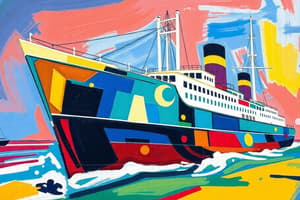Podcast
Questions and Answers
What is the light displacement of the ship?
What is the light displacement of the ship?
- 2600 tonnes
- 2800 tonnes
- 2400 tonnes (correct)
- 2200 tonnes
What is the load displacement of the ship when cargo is equally distributed in CH#2?
What is the load displacement of the ship when cargo is equally distributed in CH#2?
- 2520 tonnes (correct)
- 2620 tonnes
- 2320 tonnes
- 2420 tonnes
What is the linear density of the cargo in CH#2?
What is the linear density of the cargo in CH#2?
- 6 t/m (correct)
- 7 t/m
- 8 t/m
- 5 t/m
What is the length of CH#2?
What is the length of CH#2?
What is the volume of the ship?
What is the volume of the ship?
What is the density of the water used in the calculation?
What is the density of the water used in the calculation?
What is the primary purpose of stress tables in ship design?
What is the primary purpose of stress tables in ship design?
What does a stress table provide information about?
What does a stress table provide information about?
What is the relationship represented in a stress table?
What is the relationship represented in a stress table?
Who uses stress tables to ensure a ship's stability and structural integrity?
Who uses stress tables to ensure a ship's stability and structural integrity?
What is the unit of measurement for the allowable bending moment in a stress table?
What is the unit of measurement for the allowable bending moment in a stress table?
What is the purpose of analyzing stress tables in ship design?
What is the purpose of analyzing stress tables in ship design?
What is the primary purpose of stress tables in ship design?
What is the primary purpose of stress tables in ship design?
What is the main challenge in calculating the necessary strength of ship structures?
What is the main challenge in calculating the necessary strength of ship structures?
Which of the following is a dynamical force acting on a ship structure?
Which of the following is a dynamical force acting on a ship structure?
What is the purpose of classification societies in ship design?
What is the purpose of classification societies in ship design?
What is the bending of ships likened to in many cases?
What is the bending of ships likened to in many cases?
Which of the following is a statical force acting on a ship structure?
Which of the following is a statical force acting on a ship structure?
Flashcards
Light Displacement
Light Displacement
The weight of water displaced by the ship when it is empty.
Load Displacement
Load Displacement
The total weight of the ship when fully loaded, with cargo equally distributed in CH#2.
Linear Density of Cargo
Linear Density of Cargo
The mass of cargo per unit length in CH#2.
Length of CH#2
Length of CH#2
Signup and view all the flashcards
Volume of the Ship
Volume of the Ship
Signup and view all the flashcards
Density of Water
Density of Water
Signup and view all the flashcards
Purpose of Stress Tables
Purpose of Stress Tables
Signup and view all the flashcards
Stress Table Information
Stress Table Information
Signup and view all the flashcards
Stress Table Relationship
Stress Table Relationship
Signup and view all the flashcards
Analyzing Stress Tables
Analyzing Stress Tables
Signup and view all the flashcards
Primary Purpose of Stress Tables
Primary Purpose of Stress Tables
Signup and view all the flashcards
Challenge in Strength Calculation
Challenge in Strength Calculation
Signup and view all the flashcards
Dynamical Force
Dynamical Force
Signup and view all the flashcards
Purpose of Classification Societies
Purpose of Classification Societies
Signup and view all the flashcards
Ship Bending Analogy
Ship Bending Analogy
Signup and view all the flashcards
Statical Force
Statical Force
Signup and view all the flashcards
Study Notes
Shear Force and Bending Moment Diagram
- Load curve represents the distribution of weight along the ship's length
- Light displacement = (L x B x D) x density = 2400 tonnes
- Light displacement / length overall = 40 t/m (on lightweight)
- Cargo equally distributed in CH#2 (Trimmed): 120 tonnes / 20m = 6 t/m (on deadweight)
- Load displacement = light displacement + load weight (or deadweight) = 2520 tonnes
- Load displacement / length overall = 2520 t / 60 m = 42 t/m (on buoyancy)
Stress Tables and Ship Stability
- Stress tables represent the relationship between applied stress and corresponding deflection of the ship's hull
- Used to assess a ship's structural integrity and stability under various loading conditions
- Essential tool for naval architects and engineers to ensure ship's structure remains within safe limits during operation
- Typical stress table contains information about ship's structural members (frames, bulkheads, decks, hull plating) and maximum allowable stresses or loads
Beam Theory and Bending of Ships
- Bending of ships likened to bending of beams
- Calculating necessary strength of ships made difficult by varied forces (statical and dynamical)
- Statical forces include weight of structure, buoyancy forces, hydrostatic pressure, and concentrated local weights
- Dynamical forces include pitching, heaving, and rolling due to wind and waves
Studying That Suits You
Use AI to generate personalized quizzes and flashcards to suit your learning preferences.




